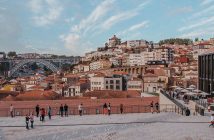I first visited Cuba in 2015. A trip where I left feeling inspired having toured writing hero Ernest Hemmingway’s house, driven in the back and front seat of a 1950’s Chevrolet, learnt how to roll and smoke a cigar, and tasted the nectar of the Rum gods in any combination of straight-up and cocktail-infused ways. In 2018 I returned, and while on one hand there was the temptation to think I’d already seen it all, on the other, a deeper sense of empathy inspired by my first time here, meant I knew there were many more layers to be uncovered.
In the open atrium of an old theatre or perhaps one-time music hall of Havana’s ‘old town’, planes of water from hot, thundery showers glisten on concrete floors beneath us. The building’s architecture is reflected in these puddles: the height of the walls that encase our scene – great patchwork pillars of faded pink and grey, shuttered windows missing their wooden slats, and a roof that is only 70 percent covered – bright rays of sunlight now streaming in like lasers.

In this venue, memories of years gone by are drawn to front of mind with cloakroom style coat hooks on one side, and wire-bound naked chairs, free from any upholstery. This is a skeleton of a building, reminiscent of all that once was, where you can practically hear the music that once penetrated out from behind closed doors on sultry evenings, if you were to just press your ear against a pillar or a door.
“What these walls must have once seen?!’ says a colleague later on that day as we are driving through the crumbling, grandiose villas that form part of the Vedado neighbourhood. He refers to conversations that would have taken place in the 1920’s dining rooms here, where drinks were liberally served and hot topics of the day were discussed. Colourful characters, dressed up in finery returning home from parties or those more conservatively attired rushing home from school to greet older family members after a hard day’s work.
In Cuba, there is no doubt that the past is omnipresent. In many ways, visiting, or indeed living here is like being stuck in a curious time-warp – one that on a surface level is frequently enjoyed and often glamourised by all who visit her. The reality, measured perhaps by our own Western standards, is the acknowledgement instead that progress is a much slower, more challenging affair. But despite these sticky political undertones, there are huge waves of colour on what is the flip side to all this – evidence of a vibrant ‘Cuba Moderna’ – and something we witness today in this old theatre.

Flashes of bright modernity are shown to us here through billowing yellow skirts, ones that in the wet mirror of the dancefloor, make the stage turn a vivid shade of gold as the hue leaks out across it. We are watching raíces profundas, a contemporary Cuban dance troupe who bring African heritage together with Spanish dance, in a powerful, impassioned and provocative way. There is a loud commitment to this kind of art that seeps from each one of the athletic troupe – those both young, and older.
The blue, red, yellow and green-tinged discs that rotate through daily life here are testament to an imagination that inhabits the current generation of Cubans. On the dining scene, creativity comes to the fore, with new paladares (privately-owned, rather than state-run, restaurants) opening all the time – check out La Concordia (421 Concordia), El del Frente (303 O’Reilly) and Casa Miglis (Lealtad 120) for the most notable of recent additions.
Locally sourced dishes are tasty and impressive – while creative cocktail matching brings Havana haunts to a level on par with the rest of the world (and prompting the more traditionally famous places here to now feel a little outdated – sorry, Floridita). There are new hotel openings too, raising the luxury stakes – check out the bar and rooftop infinity pool at the Kempinsky Hotel Gran Manzana (Calle San Rafael – between Monserrate and Zuzuleta), for the latest opening to rival the Hotel Nacional, or Hotel Sevilla – Havana’s original luxury lodging and much-talked about Hemmingway favourite.

In music too, there is another nod to where emerging Cuban talent prevails. The original destination for feet-tapping rumba, salsa, afro-cubana jazz, danzón and soukous, Cuba’s capital in particular builds on this each year with what is now known for being a growing hub for world-class musicians. In the last decade or so, this has often been thanks to the Havana Cultura programme, something set up by recently retired Francois Renié – long time much revered Communications Director of Havana Club rum, who has provided many of these artists with a global platform as well as bringing international stars like Gilles Peterson to Cuba too. Daymé Arocena is just one example of an artist who found her way to international acclaim this way, and someone whose upbeat rhythmic voice we are happy listeners to during our last night in Havana Club’s company.
All in all, our visit this time round has been illuminatory and sensory. The many and varied ingredients that go into an altogether modern Cuban cocktail of culture – the music, the art, the dancing, the emoción, the salty crashes of the waves against the iconic Malecón. This is a place where people are their authentic selves, and where (without constant connectivity to the internet – wifi is a rare and treasured treat), there is not only a blissful lack of comparison, but it is still possible, even normal, to talk to people, and live in the moment. Within this friendly, fortunate atmosphere, there is an overriding sense that in 2018 Cuba, and Havana more specifically, is a place where older heritage and tradition meets more youthful, vibrant conviction.
For more information about Cuba’s transforming cultural scene, visit www.havana-club.com.




